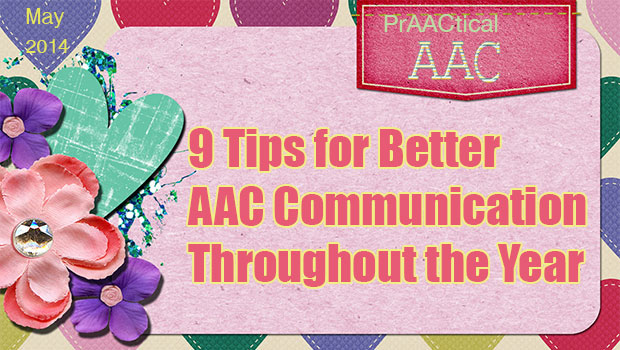9 Tips for Better AAC Communication Throughout the Year

Although Better Hearing and Speech Month is ending, we want to continue best prAACtices in all teaching interactions throughout the year. Here are 9 AAC facilitator tips to help with this goal.
- Provide Aided Language Input (ALI)– ALI is modeling AAC style. Speak AAC to the AAC user.
- Use Scaffolding– Scaffolding is a verbal and visual strategy that has the facilitator build upon prior knowledge of the learner in order for the learner to integrate a new concept or skill. Model words and concepts to add information onto what the AAC user already knows and uses.
- Provide Expansions and Extensions– A form of modeling. Add a word to the spontaneous communication from the learner. The facilitator models a conceptual or grammatical word in the form of a model.
- Use Recasting– Recasts serve to add or correct information without obstructing the natural flow of communication. Recasting is another form of modelling. The recast occurs when the facilitator modifies a learners utterance by adding new or different grammar (syntactic) or word meaning information (semantic) information.
- Add Pause Time-Set up a communication opportunity and wait……Stop, look expectantly at the learner and wait. Use the ‘pregnant pause’ and be amazed at the spontaneous initiations you will get.
- Create Communication Opportunities– Set up situations that will make it most likely to elicit communication. Communication opportunities can also be called communication temptations. Think of bubbles with the cap closed, or toys in a closed container, or moving a favorite piece of furniture to a different location.
- Decrease Use of Questions– Questions tend to be demands to talk and not many people like demands in their conversational time. Questions tend to elicit one word answers rather than complex spontaneous utterances. Learn to elicit conversation by providing comments and using pause time rather than asking questions.
- Develop No-Tech Visual Strategies– No- tech visual supports can help with positive behavior, conversational skills, boundaries, and provide clear expectations.
- Provide Appropriate Feedback– Feedback guides learning by providing new information relative to the communication goal. Appropriate feedback may involve reinforcing ‘good ideas’, or may be an expansion and extension. It definitely corresponds to the intent of the communication message as well as the main goal. It does not correspond to ‘good talking’.
Filed under: PrAACtical Thinking
Tagged With: teaching strategies
This post was written by Robin Parker





3 Comments
THANK YOU! This is a great resource for me. I am a parent of an AAC user. This site has a wealth of information and useful tips all in one spot. Searching the internet has not been as helpful as what you have created here.
Mary, so glad that you’ve found our posts helpful! Thanks for taking the time to comment. 🙂
Thank you so much for this blog–I provide professional development for educators, parents, and therapists that work with students with complex communication needs, and the resources you share I happily pass on to others.
Every posting gives me more tools to share and I greatly appreciate it!